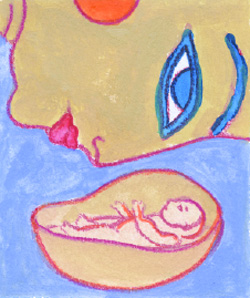Being Jewish
Commentary
Telling the Story, and Eating It

In medieval Haggadot, it was not unusual to find an illustration of maror—the bitter herb on the Seder plate—in a woman’s form.
In the partner, or “twin brother,” to the Rylands Spanish Haggadah (c. 1360), a man points to his wife while reciting “this bitter herb.” In the Munich Haggadah (c. 1300), a man puts his hand over his wife’s head at this spot. In the Washington Haggadah (1478), Joel ben Simeon depicted a man holding lettuce leaves in his left hand with his right hand on his wife’s head. She rests her right hand on a sword pointing to the ground. A mid-15th-century Haggada shows a husband at the Seder holding his maror and pointing to his wife on the other side of the table. She points back. A horseradish sits in the middle of the table, aptly symbolic of their relationship.
And we thought the Seder was a happy family occasion!
These illustrations accompany the Haggada text, often as a contemporary interpretation. Just as we have the four sons depicted according to the conventions of different illustrators, so do we often find the depiction of women in the Haggada displaying their place in that society.
As we celebrate Pesah this year (beginning on the evening of April 14), we fulfill our storytelling obligation by eating symbolic foods: the (paschal) lamb, matza and maror. These foods are not in addition to the story. They are the story. As we ingest these foods, we are swallowing the Exodus narrative. The saltwater is our tears. The bread of affliction is our daily ration. The bitter herbs intensify in our nostrils and our throats the strangulation of slavery.
Why do we eat this maror? Because the Egyptians embittered our fathers’ lives in Egypt, as it is said (Exodus 1:14): “They made their lives bitter with hard service, with mortar and with bricks, and with all manner of service in the field; all their service which they made them serve with rigor.” In every generation, a person is to regard himself as if he had come out of Egypt: “You shall tell your child on that day, it is because of this that the Lord did for me when I left Egypt” (Exodus 13:8).
In trying to make the story relevant—as demanded by the Haggada—medieval artists found an image that would help people understand bitterness: a trying marital situation.
And yet, paradoxically, while medieval Haggadot vilify women, the Talmud itself celebrated Passover’s female leadership. Women are obligated to drink four cups of wine representing four biblical Hebrew verbs of redemption precisely because they were instrumental in bringing about the Exodus. “In the merit of the righteous women,” the Talmud states, “our ancestors were redeemed from Egypt” (Babylonian Talmud Sota 11b).
In Exodus 1 and 2, we read of midwives who risked all to spare Hebrew boys. Despite Pharaoh’s decree, Moses’ mother was joyful about his birth; “and it was good,” the text declares. Miriam protected the infant Moses and later led women in a dance. Pharaoh’s daughter took Moses in and raised him. The Talmud credits women with seducing their husbands despite daily suffering to bring more children into the world.
While historically the medieval images are disturbing and intriguing, they must be put aside in light of the overriding biblical and legal tribute to the women of Exodus. The Talmud says that women must ritualize freedom today because they were instrumental in creating it. If children represent faith in the future, the women of Exodus knew that a different future lay ahead. They literally birthed their redemption.
Erica Brown, Ph.D., is scholar-in-residence for the Jewish Federation of Greater Washington. Her latest book is Happier Endings: A Meditation on Life and Death (Simon & Schuster).








 Facebook
Facebook Instagram
Instagram Twitter
Twitter
Leave a Reply